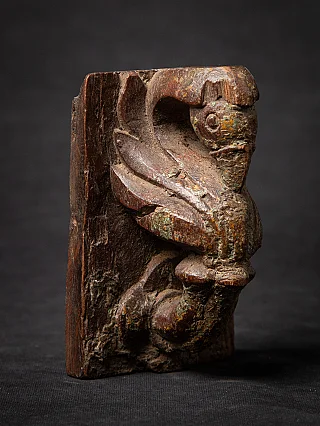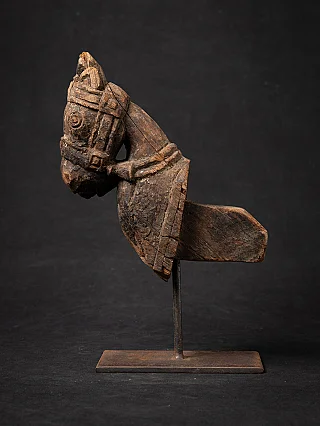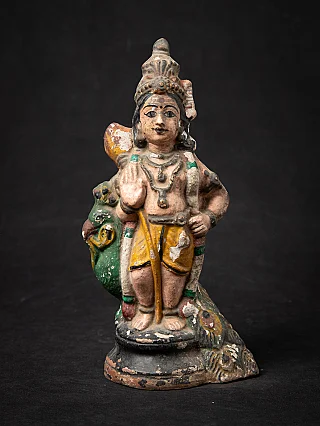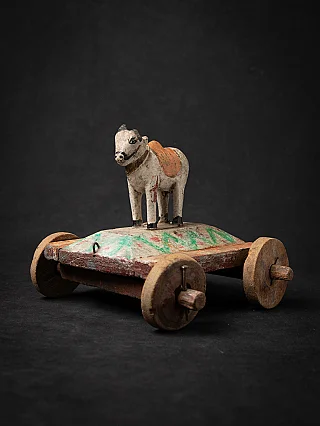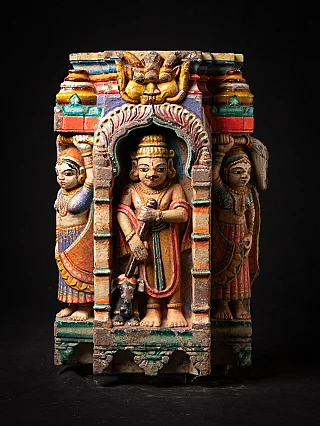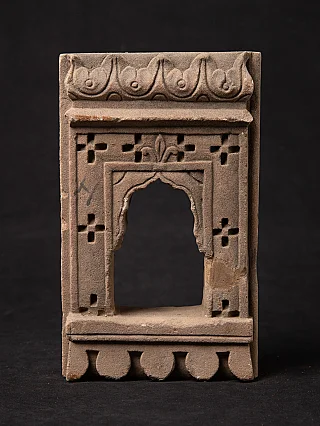Nataraj - The Dancing Shiva
Author : Peter Vredeveld

Nataraj, the celestial dancer, is a revered deity in Hindu mythology whose cosmic dance symbolizes the eternal cycle of creation and destruction. With intricate symbolism and profound spiritual significance, the image of Nataraj captures the essence of the universe's perpetual motion and the interplay of various forces that govern existence. Originating from ancient scriptures and texts, the concept of Nataraj has evolved over millennia, encompassing diverse interpretations and cultural expressions across different regions of the Indian subcontinent and beyond.
Etymology
The term "Nataraj" is derived from the amalgamation of two Sanskrit words: "Nata," meaning dance, and "Raja," meaning king or lord. Together, they encapsulate the essence of Nataraj as the Supreme Lord of Dance. This title signifies not only Nataraj's mastery over the art of dance but also his transcendental sovereignty over the cosmic dance of creation, preservation, and dissolution. In Hindu mythology, Nataraj is often referred to by various epithets, each highlighting a different aspect of his divine persona. Some of the commonly used titles include "Natesa" (Lord of Dancers), "Nrityapriya" (Lover of Dance), and "Ananda Tandava" (Blissful Dance). These names reflect the multifaceted nature of Nataraj's symbolism and his profound impact on devotees' spiritual and artistic pursuits.
Depiction

The depiction of Nataraj, the Lord of Dance, holds profound significance in Hindu iconography, encapsulating rich symbolism and spiritual truths. Through intricate details and dynamic poses, Nataraj's image conveys the cosmic dance of creation and destruction, inviting contemplation and interpretation. The various elements of Nataraj's portrayal that contribute to the profound symbolism and spiritual depth of his divine form are:
- The iconic image of Nataraj depicts the Lord of Dance.
- Captures profound philosophical concepts and spiritual truths.
- Laden with symbolism, each element conveys layers of meaning.
- Nataraj's dynamic dance symbolizes the cosmic rhythm.
- Ananda Tandava represents the blissful dance of divine ecstasy.
- Depicted with one leg raised gracefully, the other on demon Apasmara.
- Symbolizes the eternal cycle of life, death, and renewal.
- Four arms extend outward, each carrying symbolic objects.
- The upper right-hand holds the Damaru, symbolizing creation's sound.
- The upper left-hand holds a flame representing destruction.
- The lower right hand in Abhaya Mudra imparts fearlessness.
- The lower left-hand points downward, symbolizing liberation.
- Encircled by flames representing cosmic fire and time's cyclical nature.
- The divine form is often depicted within a circular halo or Prabha Mandala.
- The mandala symbolizes the cosmic egg and the life, death, and rebirth cycle.
Symbolism and Iconography

The iconic image of Nataraj, with its intricate symbolism and rich iconography, is a visual metaphor for the cosmic principles and spiritual truths elucidated in Hindu mythology and philosophy. Each element of Nataraj's depiction conveys profound symbolism, inviting devotees to contemplate the deeper meanings hidden within the divine dance.
- Cosmic Dance (Tandava): His dynamic dance, the Tandava, is at the heart of Nataraj's iconography. This dance symbolizes the eternal rhythm of creation, preservation, and destruction, reflecting the cyclical nature of existence and the cosmic order. Nataraj's graceful movements embody the harmonious interplay of cosmic forces, illustrating the interconnectedness of all things. The Tandava is divided into two aspects: Ananda Tandava, representing the blissful dance of creation, and Rudra Tandava, representing the fierce dance of destruction. Both aspects illustrate the multifaceted nature of Shiva's cosmic dance, encompassing creation and dissolution within its divine rhythm.
- Four Arms: Nataraj is depicted with four arms, each carrying symbolic objects representing different aspects of his divine persona. The upper right-hand holds the Damaru, a small drum symbolizing the sound of creation, while the upper left-hand holds a flame representing destruction. The lower right hand is raised in the Abhaya Mudra, signifying protection and fearlessness, while the lower left-hand points downward, symbolizing liberation from worldly attachments.
- Apasmara: Beneath Nataraj's feet lies Apasmara, a dwarf demon representing ignorance and illusion. By subduing Apasmara, Nataraj signifies the triumph of divine knowledge over ignorance, illuminating the path to spiritual enlightenment and liberation from the cycle of birth and death.
- Prabha Mandala: Surrounding Nataraj is a circular aureole or Prabha Mandala, representing the cosmic egg or the wheel of samsara. This mandala symbolizes the cyclical nature of time and the eternal dance of creation unfolding within the universe.
- Serpent: Adorning Nataraj's waist is a serpent, representing the kundalini energy coiled at the base of the spine. As Nataraj dances, the serpent symbolizes the awakening of spiritual consciousness and the ascent of divine energy towards enlightenment.
- Crescent Moon: A crescent moon adorns Nataraj's matted hair, symbolizing the cyclical nature of time and the waxing and waning phases of the lunar cycle. The crescent moon also represents the divine feminine energy, complementing Nataraj's masculine form in a harmonious union of opposites.
Various Dance Forms of Nataraj
The cosmic dancer Nataraj is associated with various dance forms, each expressing different aspects of his divine persona and the cosmic principles he embodies. These dance forms are artistic representations and profound symbols that convey deep philosophical truths. Some of the prominent dance forms associated with Nataraj include:
- Ananda Tandava: The blissful dance of Nataraj symbolizes the joy of creation and the divine ecstasy experienced by the cosmic dancer.
- Rudra Tandava: The fierce dance of Nataraj represents the destructive aspect of Shiva as the destroyer of ignorance and the transformer of the universe.
- Lasya: A gentle and graceful form of dance associated with Nataraj, often depicted alongside the dynamic Tandava. Lasya represents the feminine aspect of creation and the softer, more nurturing qualities of the divine.
- Kalari Natanam: A martial form of dance associated with Nataraj, particularly prevalent in the southern regions of India. This form emphasizes strength, agility, and discipline, reflecting Nataraj's role as a protector and warrior.
- Cosmic Dance: Nataraj's dance is often described as the cosmic dance, encompassing both the creative and destructive forces of the universe. This form symbolizes the eternal cycle of birth, death, and rebirth, illustrating the interconnectedness of all existence.
- Nataraja Nritya: The specific dance style attributed to Nataraj is characterized by intricate footwork, expressive gestures, and dynamic movements. Nataraja Nritya is regarded as the epitome of divine dance, embodying the essence of Shiva's cosmic presence.
These various dance forms enrich the portrayal of Nataraj as the Lord of Dance, offering insights into the multifaceted nature of his divine expression and the profound significance of his cosmic dance.
Variations and Interpretations of Nataraj
While Nataraj, the celestial dancer, represents a specific form of Lord Shiva in Hindu theology, variations and interpretations of his depiction exist across different cultural and regional contexts. These variations highlight diverse aspects of Nataraj's symbolism and cultural significance, enriching the understanding of his cosmic dance and its profound implications.
- Regional Depictions: Across various regions of the Indian subcontinent, artists and artisans have depicted Nataraj in unique styles that reflect local traditions and artistic sensibilities. For example, in the southern state of Tamil Nadu, Nataraj is often depicted as "Kalari Nataraja," emphasizing his martial aspect and association with the ancient art of Kalari Payattu. In contrast, in northern India, Nataraj may be depicted with distinct iconographic features influenced by local customs and religious practices.
- Symbolic Representations: Beyond regional variations, Nataraj's depiction also encompasses a range of symbolic representations that convey different layers of meaning and philosophical insights. Artists and scholars have interpreted Nataraj's dance as a metaphor for the eternal rhythm of the cosmos, the interplay of masculine and feminine energies, and the cyclical nature of existence. Each symbolic representation offers a unique perspective on Nataraj's divine dance and its significance in the spiritual quest for enlightenment.
By exploring these variations and interpretations of Nataraj's depiction, we gain a deeper appreciation for the richness and diversity of Hindu mythology and its artistic expressions. Whether portrayed in classical iconography or reimagined in contemporary art, Nataraj's image inspires awe and contemplation, inviting devotees to delve into the mysteries of creation, preservation, and transformation.
Share this page


















